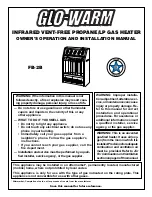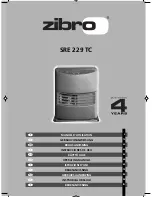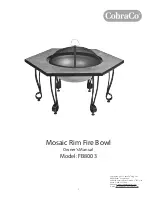
6 720 680 226
20
Installation instructions
3.4
Combustion air requirements
Twin pipe and Concentric pipe
The water heater is designed as a sealed combustion
appliance. It is recommended that the combustion air
be provided by a dedicated 3” or 4” pipe from the
outside (twin pipe) or by connecting to the Concentric
vent kit (see Fig. 8). The combustion air pipe may be
PVC or any other rigid sealed 3" or 4" pipe. The
combustion air piping must pitch down 1/4 inch per
foot towards termination to prevent rain water from
entering the appliance. In twin pipe penetrations,
combustion air inlet, whether terminating vertically or
horizontally,
must be located in such a manner as
to provide a minimum 3 foot clearance from the
exhaust vent terminator.
See Fig. 9 and 10 Letter I,
page 12.
For the maximum length of the combustion air
pipe, see Tables
5
&
6.
Single pipe
Note:
This appliance requires 9950 cubic feet of
available combustion air, or a minimum of 1243
square feet of space with an 8 foot ceiling to
operate. If the large amount of air space, which
equates to about half of most average sized
homes, is not available, the appliance must pull
air from the outside (see twin pipe above).
Although it is permissible to draw combustion air from
the inside, it is not the manufacturer’s recommended
installation method. Always install a 3 inch 90° elbow on
the top of the combustion air inlet adaptor to prevent
foreign objects from falling into the unit.
If a single pipe installation is utilized, follow guidelines
below for providing adequate combustion air for the
water heater as well as any other appliances that may
consume air in the same space. Always follow local
codes if they are more stringent and regulations.
•
Appliances located in unconfined spaces:
–
a)
An unconfined space is one whose volume is
greater than 50 cubic feet (1.42 cubic meter) per
1000 Btu per hour (292.81 Watts) of the
combined rating of all appliances installed in the
space. That would be 9950 cubic feet (281.8
cubic meters) for the water heater alone.
– b) In unconfined spaces in buildings of
conventional
frame,
masonry,
or
metal
construction, infiltration air is normally adequate to
provide air for combustion.
•
Appliances located in confined spaces:
The confined space must be provided with two per-
manent openings, one commencing within 12 inches
(304.8mm) of the top and one commencing within
12 inches (304.8mm) of the bottom of the enclosure.
Each opening must have a minimum free area of one
square inch per:
– 1000 Btu/hr (292.81 Watts) if all air is taken from
inside the building
– 2000 Btu/hr (585.62 Watts) if all air is taken from
the outside by horizontal ducts
– 4000 Btu/hr (1171.24 Watts)if all air is taken from
the outside by direct openings or vertical ducts
Or the confined space must be provided with one
permanent opening or duct that is within 12 inches
(304.8mm) of the ceiling of the enclosure. This opening
must have a minimum free area of one square inch per:
– 3000 Btu/hr (878.43 Watts) if all air is taken from
the outside by a direct opening or vertical duct.
Louvers, grills and screens have a blocking effect, when
used, increase the sizes of your openings by 300% for
wood louvers (as wood type will reduce the free air by
75%) and 43% for metal louvers (as metal will reduce
the free air by 30%). Refer to the National Fuel Gas
Code for complete information. In buildings of tight
construction all air should be taken from outside.
Warning:
In areas where outside
temperatures routinely come close to
freezing, sealed combustion operation
is
required.
Use
a
concentric
termination or separate terminations for
combustion and vent, which must be
installed on the same wall or roof
surface, however never facing the
direction of prevailing winds. Failure to
do so may result in heat exchanger
freezing up and bursting. This failure is
not covered under the manufacturer's
warranty.
Warning:
When installed in an
environment where corrosive chemicals
or dirty air (e.g. hair salons, car washes)
are present the twin pipe system is
required.
Warning:
Terminations must prevent
rain and debris from entering the
combustion air and exhaust vent piping.
















































